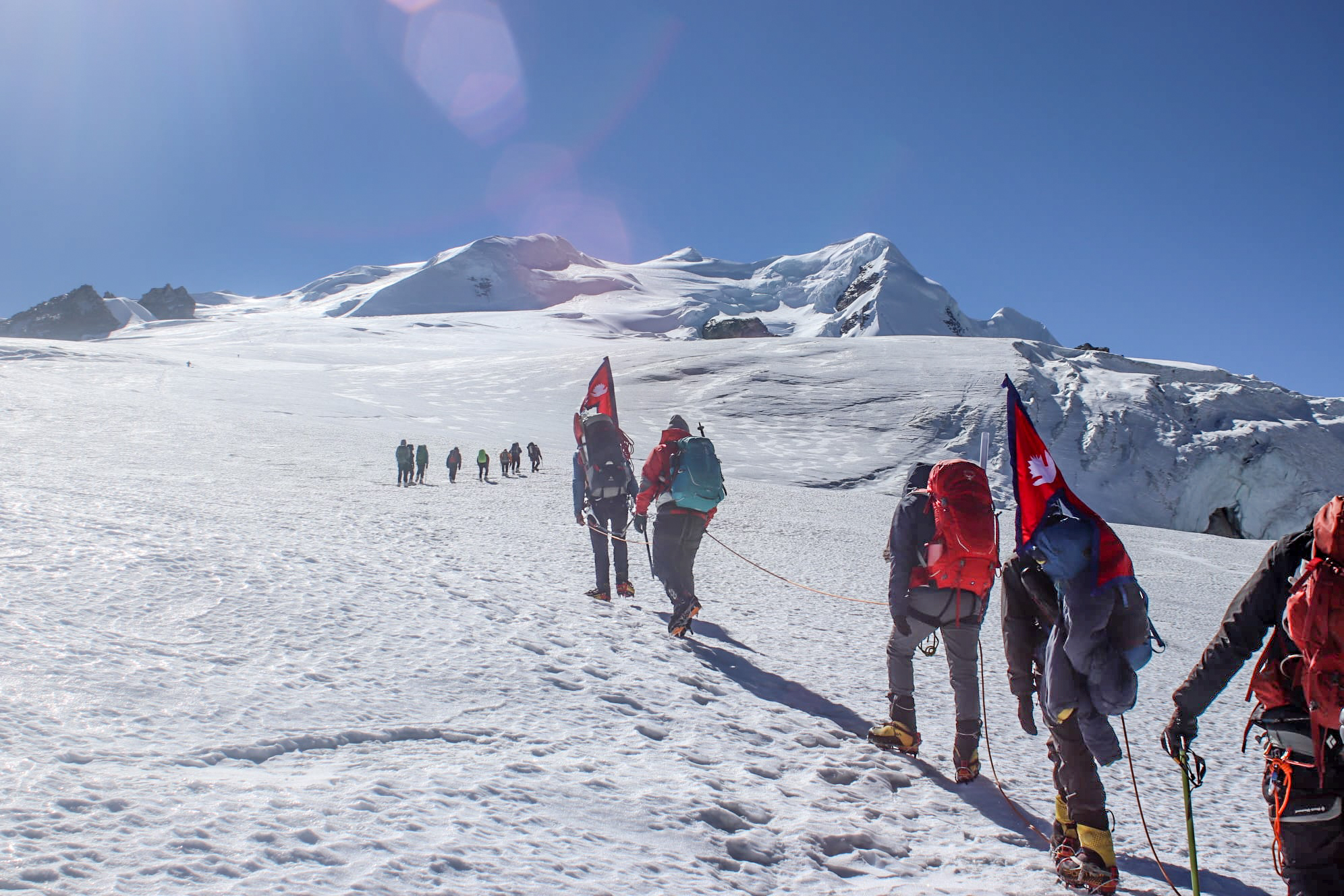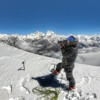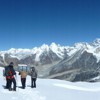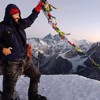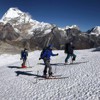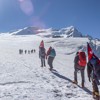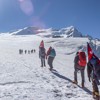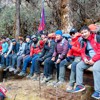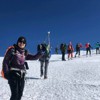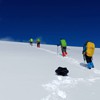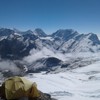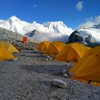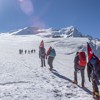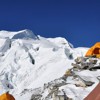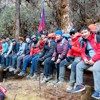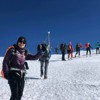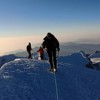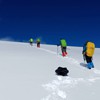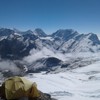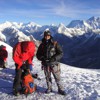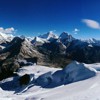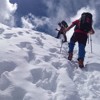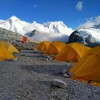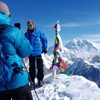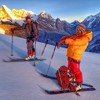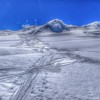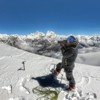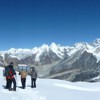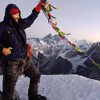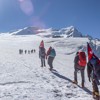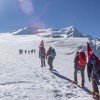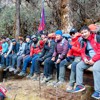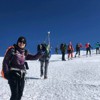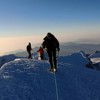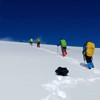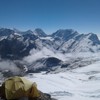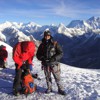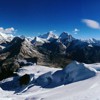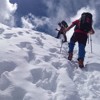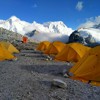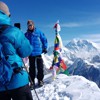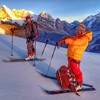Mera Peak Tour - 14 Days
Unknown
NPR 54,999
Flexible Cancellation Policy & Fair Prices
FIXED DEPARTURES: 19 Sept, 30 Sept, 12 Oct, 19 Oct, 29 Oct, 9 Nov INCLUDES Transport to Bung and Flights to KTM from Lukla Climbing Training in Kathmandu Accommodation for 14 nights Breakfast, Lunch, Dinner & Hot Drinks Trekking & Climbing Guide Staff Insurance Mera Peak Climbing Gear / Permit / Certificate
Not Available
Flexible Cancellation Policy & Fair Prices
Not Available
Not Available
Flexible Cancellation Policy & Fair Prices
Not Available
HIGHLIGHTS
- Climb Mera Peak (6,470 meters), the highest but technically easy trekking peak in Nepal and get a certificate for it. :)
- Get awed by the view from the top that includes Mount Everest, Kanchenjunga, Lhotse, Makalu, and Cho Oyo.
- Have a different experience everyday, from a scenic drive, to a culture walk, to high altitude lakes, to glacier walk, to camping to summit!
- Take your family with you till Khare and reconnect with them after summitting Mera Peak.
- Visit the beautiful Khiraule & Thangnak Gompa, along with Panch Pokhari and Tama Pokhari Lakes.
QUICK FACTS
- Difficulty LevelHard
- Total Length89 km
- Highest Altitude6,470 meters
- Elevation Profile
- Start locationBung (1,700 meters)
- Finish locationLukla (2,850m)
- PermitsMakalu Barun NP Permit, NMA Climbing Permit
- Best SeasonMarch-May & September-November
DAY TO DAY ITINERARY
- Kathmandu
(1,400 m)
- Ghurmi
( m)
- Patale Dhap
( m)
- Patale Dhap
( m)
- Bung
( m)
- Khiraule Gomba
( m)
- Khiraule Gomba
( m)
- Chharkhor
( m)
- Jungle Camp
( m)
- Jungle Camp
( m)
- Panch Pokhari
( m)
- Panch Pokhari
( m)
- Kothe
(3,592 m)
- Khare
(4,880 m)
- Khare
(4,880 m)
- Mera High Camp
( m)
- Mera High Camp
( m)
- Mera Peak
( m)
- Khare
(4,880 m)
- Kothe
(3,592 m)
- Taktor
( m)
- Thuli Kharka
( m)
- Thuli Kharka
( m)
- Chhutenga
( m)
- Lukla
(2,850 m)
DESCRIPTION
While climbing a mountain might make this tour looks a bit daunting, Mera Peak doesn't require you to climb vertical faces. As such, rather than a proper mountaineering peak, it is considered a trekking peak by the Nepal government and is regulated differently. That is not to say that it is a walk in the park as 6,470 meters is still pretty high and there are risks that need to be managed on this tour. But, the point if if you think you are fit to do the Everest Base Camp Trek, you are probably fit to take on Mera Peak too. :)
It is also possible to just do the trekking portion of this tour till Khare, or take your family who will accompany you till Khare and reconnect with you two days later after Mera climb. The trek is also unique as it passes through different terrains everyday.
Long story short, Mera Peak Tour is within the reach of most reasonably fit people and the trek till Khare can be done by anybody.
SAFETY MEASURES Climbing Training on Day 8 / Oxygen Cylinder($) / Gamow Bag / Ski stretcher / First Aid Kit / Oximeter and BP Meter / Accidental and Health Insurance up to 15 lakhs / Experienced Mountain Guides with Wilderness First Aid Training / Satellite Phone
HoneyGuide's Approach Please note that HoneyGuide encourages small private groups over large mixed ones. And while we usually have no minimum group sizes on our trekking tours, we do have a minimum 5 pax requirement for this tour. However, there are no fixed departure dates and you can choose your own dates. :)
DAY 1: Everest View ~ Drive from Kathmandu to Patale Dhaap (2900m) via BP Highway. (8 hrs) ~ Lunch at Ghurmi. ~ First view of Mount Everest.
DAY 2: Buddhist Culture ~ Drive from Patale Dhaap to Bung (1,700 m)- 6 hours ~ Overnight next to the 300 year old Khiraule Gompa (2600m) - 2 hrs hike.
DAY 3: Rhododendron Trail ~ Walk through rhododendron forests and bamboo thickets to overnight at Cholem (3,560m)- 4 hrs ~ Watch out to Red Pandas along the trail.
DAY 4: High Altitude Lakes ~ Walk through high altitude landscape with views of Kusum Kanguru, Kyashar and Kanchenjunga. ~ Chances of seeing Danfe and Blood Pheasants are very high on this section. ~ Overnight at Panch Pokhari (4,223 m), a scenic and religious place. 6 hours walk
DAY 5: Conifers Unlimited ~ Walk through pine forests along the Inkhu Khola to reach Kothe (3,580 m) in around 4 hours.
DAY 6: Alpine Pastures ~ Walk along the Inkhu Khola and end the trek at Thangnag (4,350 m), a settlement in an alpine pasture.
DAY 7: Glacier Walk ~ Walk through high mountain with glaciers all around you. ~ Pass through Tama Pokhari. ~ Overnight at Khare (5,000 m) - 4 hrs.
DAY 8: Climbing Training ~ Acclimatization and Climbing Training at Khare.
DAY 9: Camping Day ~ Walk along the Mera Glacier and trek to Mera Base Camp (5,350 m) past the Mera La Pass (5,415m). ~ Overnight camping at Mera High Camp (5,800 m)- 5 hours. ~ Enjoy breathtaking views of Mt. Everest, Kusum Kanguru, Mt. Baruntse, Mt. Makalu and if you are lucky Mt Kanchenjunga.
DAY 10: Summit Day ~ Wake up at 3 am and slowly make your way to Mera Peak (6,461m) for sunrise. ~ The view of Mt. Everest, Makalu, Lhotse, Cho-Oyu, Kanchenjunga is sure to leave you speechless. ~ Return to Khare (5,000m) after summiting Mera Peak. 8 hours.
DAY 11: Celebration Day ~ A short and easy day which will feel very relaxed after climbing Mera Peak the day before. ~ Overnight at Kothe (3,580 m)- 5 hours.
DAY 12: Off the Map ~ Walk through pine and rhododendron forests along a trail that doesn't see trekkers at all. ~ Overnight at Thuli Kharka (4,200 m). - 5 hours.
DAY 13: High Pass to Lukla ~ Cross the 4,600 meter high Zatrwa La Pass and descend to the Dudhkoshi valley to reach Lukla (2,840m). - 5 hours. ~ Get amazing views of Cho Oyu, Kongde, Kusum Kanguru, and Numbur.
DAY 14: Lukla Flight!! ~ Fly back to Kathmandu from the famous Tenzing Hillary Airport at Lukla. (25 minutes)
INCLUSIONS AND EXCLUSIONS Includes ~ 4WD Transport Service from Kathmandu to Bung. ~ Flight from Lukla to Kathmandu ~ Accommodation for 14 days in twin sharing. ~ All meals throughout the tour. ~ Hot Drinking Water and Drinks ~ Trekking and Climbing Guide ~ Staff Insurance ~ Mera Peak Climbing Permit & Certificate ~ Mera Peak Climbing Gear ~ Accidental and Health Insurance up to NPR 15 lakhs) ~ Gamow Bag ~ Oximeter and BP Meter ~ Ski stretcher ~ Climbing Training ~ First Aid Kit
Excludes ~ Emergency Heli Rescue (~ NPR 1,00,000 to Lukla / NPR 3,00,000 to Kathmandu) ~ Beverages, alcoholic or otherwise, not included in the meals. ~ Internet Wifi Cards (Swift Net)- 6 GB for 16 hours - NPR 1,000 ~ Sleeping Bag (available for hire at Khare) ~ Satellite Phone usage (NPR 500 per minute) ~ Oxygen Use (NPR 10,000 per hour or NPR 30,000 for 4 liters) ~ Personal Expenses ~ Tips for Guides and Porters ~ Clothing ~ Porter Cost- NPR 2,000 per day (carries 30 kg and incudes his meals and accommodation.)
IMPORTANT NOTE
Clients need to be sent a PP size photo and citizenship photo for Mera Peak permit.
Also please do not forget to bring a Warm Hat, Headlight, Snow Goggles, Neck Mask, Inner gloves, Climbing gloves, Sun Cream, Lip balm, enough warm Socks, Water Bottle, and personal Medicine.
Relevant Links: Best Time and Weather / Packing List / Accommodation / Lukla Flight / WiFi, Mobile Network, and Electricity / Food and Drinks / Sherpa Food / Wildlife / Flowers / Birds
FAQS
Traveling to the mountains poses some inherent risks. As such, the best strategy is to prepare for the worst and then hope for the best.
PRE-EXISTING CONDITIONS
The first thing to keep in mind is to see if you have pre-existing conditions that could cause complications at high altitudes. Specifically, suppose you have sickle cell disease, pulmonary hypertension, obesity hypoventilation syndrome, or congenital heart problems. In that case, we highly recommend you consult with a qualified physician before planning a trip to the mountains. Read more.
ALTITUDE-ILLNESS
Given the low amount of oxygen at high altitudes, a sensible ascent is essential to give your body the time to acclimate to the thin air. Failure to do so can lead to your lungs or brain filling up with water leading to death in some cases. The key is not to climb more than 500 meters in one day once you pass the 2,500 meters mark. Read more.
ENVIRONMENTAL HAZARDS
Given the extreme weather in the high mountains, proper gear and regimen must have a safe and comfortable tour. The three most important things that you have to prepare for are cold, snow, and radiation. As such, invest in the right sunglasses, sunscreen, boots, and clothing. Read more.
TRAVEL INSURANCE
We highly recommend everyone get travel insurance covering high altitude evacuation before leaving on a trek to the high mountains. Global Rescue and World Nomads are both highly recommended. For Nepali travelers, please note that insurance that covers helicopter rescue is not available as of now. As such, please be careful while planning your tour and only work with companies that can provide timely evacuation service if needed.
RESCUE AND EMERGENCY
As health facilities are limited in the mountains, a helicopter's evacuation is usually the only option during an emergency. As such, the right insurance provider is essential. If you are not buying insurance for some reason, please ensure that there is someone in Kathmandu who can coordinate payments for a helicopter rescue. Here are some other contacts that might come in handy during an emergency. If you still have questions, please feel free to call / whatsapp us at +977-9801916215 or email Ashish at nectar@honeyguideapps.com
HOW DO I MAKE A PAYMENT?
To confirm your tour, you will have to make complete payment either through one of your integrated payment gateways or transfer the funds to the following bank accounts:
For Nepali citizens:
Account Name:: HoneyGuide Pvt. Ltd. Beneficiary Bank: Himalayan Bank, Patan Branch Account Number: 00606903770018For Indian Citizens:
For USD transfers
Account Name: HoneyGuide Apps, Inc. Bank Name: Silicon Valley Bank Account Number: 3302225311 Swift Code: SVBKUS6S ABA Routing Number: 121140399BOOKING A TOUR
Deposit Required for Reservation: 50 percent of total tour cost Deadline for Full Payment: 2 weeks before the tour begins
CHANGING A TOUR
Two weeks before tour date: No extra charge 1 to 2 weeks before tour date: 10% additional charge Two days to 1 week between tour date: 20% additional charge Within two days of tour date: Above 30% (variable)
CANCELLING A TOUR
Two weeks before tour date: No charge (transaction charges may apply) One to two weeks before tour date: 20% Cancellation Charge Two days to one week between tour date: 50% Cancellation Charge Within two days of tour date: No Refund.
DELAYS AND CHANGES DURING THE TOUR
In case of flight delays/cancellations due to bad weather or unforeseen circumstances, HoneyGuide will change the dates at no additional costs. However, any extra cost incurred, including but not limited to accommodation and food, will be the responsibility of the traveler.
In case of changes due to the trekker's health issues, HoneyGuide will make all the changes without any additional cost. However, any extra charge because of the changes will be the responsibility of the traveler.
While Nepal's mountains see six seasons, the best period to go to the mountains is from March-May and September-December. However, every season has its quirk, just like people. So keep reading to find your match.
For those going to Everest Region, do check out the Best time to go to Everest post.
January/February (Winter)
January/February is a good time for trekkers willing to brave the cold and snow for empty trails, fantastic mountain views, and wildlife sightings.
March/April (Spring)
This is a period that offers a little bit of everything: a little bit of mountain view, a little bit of warm weather, a little bit of flowers, a little bit of crowd, and a whole lot of fun.
May/June (Summer)
This is the best time for those into nature. The flowers are quite something this time of the year, and the bird activity is fantastic. The monsoon hasn't started, and as such, mornings are still clear with beautiful mountain views.
July/August (Monsoon)
Only for hardcore trekkers who are willing to put up with the elements for an authentic cultural experience and high altitude flowers. Also, flight disruptions are very likely, and chances of mountain views are close to zero.
September/October (Fall)
This period is everyone's darling, and the trails are as crowded as they can be. The mountain views are something to write home about, and the temperature is just perfect.
November/December (Pre-Winter)
Another popular period among trekkers and the driest two months in the calendar. Indeed it has gotten a bit nippy during the mornings and evenings, but it is still manageable. Count on a lot of sunshine and crystal clear mountain views.
